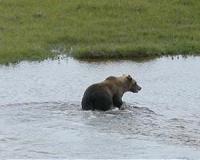| . |  |
. |
Nusa Dua, Indonesia (AFP) July 12, 2010 Representatives from 13 "tiger-range countries" met in Indonesia on Monday to draft a global recovery plan ahead of a summit in Russia in September. "We're gathering here because we share concerns about the sustainability of tigers," Indonesian Forestry Minister Zulkifli Hasan said in an opening address to delegates on the resort island of Bali. "It is alarming that out of the nine tiger subspecies in the world, only six are remaining." The plan to be drafted in Bali will be used as the basis for discussion at a "tiger summit" in St. Petersburg from September 15 to 18. "In Indonesia alone, only the Sumatran tiger still exists, while the other two subspecies have become extinct," the minister said, referring to Javan and Balinese tigers which were wiped out in the 1980s and 1940s respectively. He blamed a "lack of law enforcement" for the continuing losses of Sumatran tigers, which number only about 400 in the wild. Several are killed every year by poachers and villagers who compete with them for dwindling forest resources. WWF says the global, wild population of tigers of all species has fallen from about 100,000 to an estimated 3,200 over the past century. Countries invited to attend the St. Petersburg summit are Bangladesh, Bhutan, China, India, Indonesia, Cambodia, Laos, Malaysia, Myanmar, Nepal, Russia, Thailand and Vietnam. The pre-summit talks in Bali from Monday to Wednesday will hear details of each country's tiger protection plans and funding proposals. Indonesian conservation official Harry Santoso said ahead of the talks that Jakarta would ask for more than 175 million dollars in foreign aid to implement its plan to double the Sumatran tiger population by 2022. The plan focuses on mitigation of human-animal conflict and better law enforcement, including stiffer penalties, to stop poaching and forest destruction. Human-animal conflicts are a rising problem in the massive archipelago as forests are destroyed for timber or to make way for palm oil, forcing animals such as elephants and tigers into closer contact with people. World Bank tiger initiative director Keshav Varma said the trade in tigers and tiger products is growing despite an increasing awareness among governments that the species was on the brink of extinction. He said poachers and illegal traders were "better equipped" than ever before with weapons and communications technology. "They have become more sophisticated and there is a bigger market, not only for traditional medicine but now people want more tiger product for fashion," he told reporters. "Unfortunately countries have not done enough to stop these people."
Share This Article With Planet Earth
Related Links Darwin Today At TerraDaily.com
 Canada needs more, bigger parks to protect wildlife: study
Canada needs more, bigger parks to protect wildlife: studyOttawa (AFP) July 9, 2010 Canada's patchwork of parks must be connected, and more, bigger parks must be created in order to protect the habitats of large roaming animals, said a report Friday. Canada boasts more than 3,500 protected areas, including 42 national parks. But the Canadian Parks and Wilderness Society (CPAWS) in its report warned that several species are at risk of dying out because their designated c ... read more |
|
| The content herein, unless otherwise known to be public domain, are Copyright 1995-2010 - SpaceDaily. AFP and UPI Wire Stories are copyright Agence France-Presse and United Press International. ESA Portal Reports are copyright European Space Agency. All NASA sourced material is public domain. Additional copyrights may apply in whole or part to other bona fide parties. Advertising does not imply endorsement,agreement or approval of any opinions, statements or information provided by SpaceDaily on any Web page published or hosted by SpaceDaily. Privacy Statement |